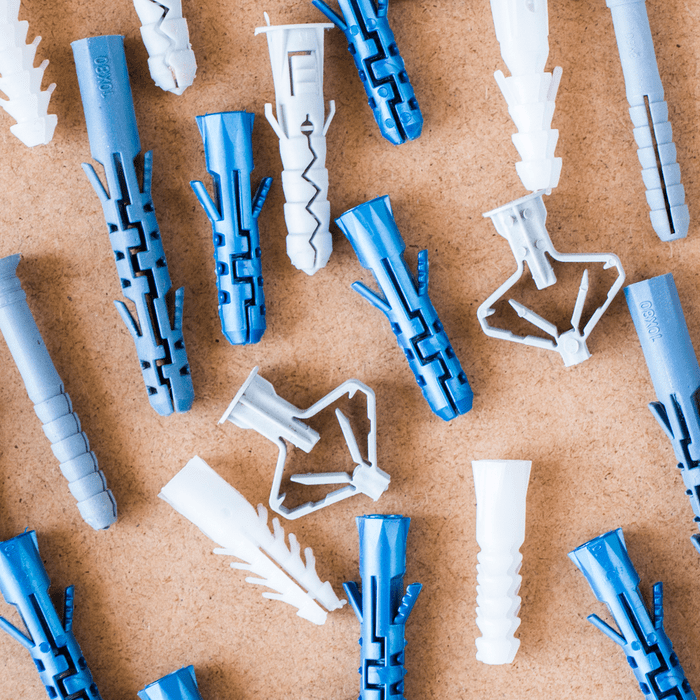Learn the key differences between drywall anchors, so you can choose the strongest, safest option for your next project.

Choosing the Right Drywall Anchor: A Complete Guide


Plastic Expansion Anchors
Cylindrical in shape with fluted ends, plastic anchors come in different sizes with varying load capacities from 5 to 25 pounds in 1/2-in. drywall.
What It Does: Plastic expansion anchors are inserted into pre-drilled holes, then expand when a screw is tightened to create a friction fit in the drywall.
What Makes It Different: Plastic expansion anchors are lightweight, inexpensive and best suited for non-structural, light-duty applications.
Pros and Cons: Plastic anchors are easy to install and don’t require a large hole in the drywall. However, they have limited holding power and may crack if over-tightened.

Molly Bolts
Molly bolts consist of a plastic or metal sleeve with strategic expansion cutouts. Available in plastic or metal options, they have weight capacities of 25 to 50 pounds in 1/2-in. drywall for medium-duty hanging projects.
What It Does: Molly bolts are first pressed into a pre-drilled hole in the drywall until flush with the surface. When a screw is inserted and tightened, the sleeve cutouts expand and fold up against the drywall for a secure hold.
What Makes It Different: Molly bolts are easy to use and hold more weight than basic plastic anchors due to their unique folding design that distributes the load over a larger area against the inside of the drywall. The screw can also be removed and replaced within the same anchor.
Pros and Cons: A great feature of molly bolts is that you can remove and reinsert the screw without losing the anchor inside the wall. These also don’t require a large hole to be drilled in the drywall. However, if installed too close to a stud or pipe, the anchor may not fully expand, which limits its applications.

Threaded Drywall Anchors
Instead of requiring a pre-drilled hole, threaded drywall anchors are designed to screw directly into the drywall. Available in plastic and metal options, these have weight capacities of 25 to 75 pounds in 1/2-in. drywall.
What It Does: Shaped like oversized screws, threaded drywall anchors have a pointed, threaded body that bites into the drywall as it’s turned with a screwdriver. Once the anchor is flush with the wall, a separate screw is inserted into the center and tightened to secure your object in place.
What Makes It Different: The self-tapping, threaded design makes this anchor type unique among drywall anchors.
Pros and Cons: I love how easy it is to install threaded anchors, and they create less mess without the pre-drilled hole. However, one downside is that if they’re not placed correctly the first time, adjusting their position can be tricky. They’re also only suitable for drywall, and will break if installed in plaster.

Toggle Bolts
These are my go-to drywall anchors for hanging televisions, heavy mirrors and large artwork, with weight capacities of 200 to 300 lbs. in 1/2-in. drywall. Traditional toggle bolts consists of a machine screw and a spring-loaded, winged toggle, while more modern versions have a flat metal toggle attached to plastic straps.
What It Does: Toggle bolts are inserted in pre-drilled holes, then secured with a machine screw. Whether winged or flat, toggle bolts pull snug against the inside surface of the drywall when fully tightened.
What Makes It Different: Toggle bolts offer some of the highest holding strength among drywall anchors and are one of the few types suitable for ceiling installations. The machine screw must match the toggle for proper threading, but different screw lengths can be used.
Pros and Cons: Toggle bolts offer excellent weight support for heavy-duty applications. They also allow for slight adjustments within the hole due to the smaller screw diameter. However, they need to secure something directly to the wall since the screw head alone won’t cover the hole. Traditional toggles fall behind the wall and cannot be reused, but flat toggles are re-usable. However, flat toggles are more expensive and the plastic components can sometimes break.




















